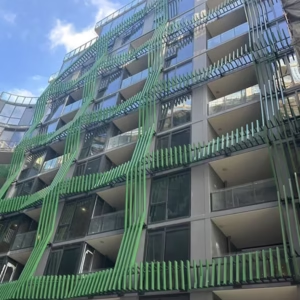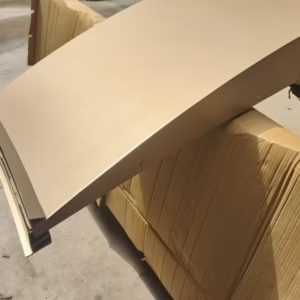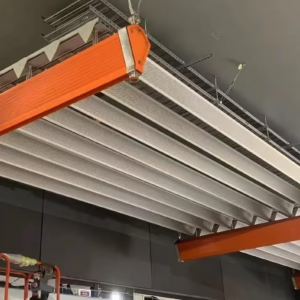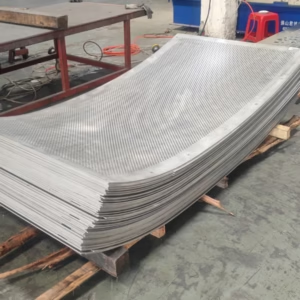1. Definizione e Valori Fondamentali del Design Personalizzato di Facciata Continua in Alluminio
Design personalizzato di facciata continua in alluminio prevede la creazione di soluzioni personalizzate per facciate in metallo attraverso processi di progettazione sistematici su misura per requisiti specifici del progetto. La sua essenza risiede nel superare i moduli standardizzati per ottenere una personalizzazione di precisione “specifica per il progetto”. Questo paradigma di design richiede una profonda comprensione del posizionamento funzionale dell'edificio, delle caratteristiche strutturali, dei parametri ambientali e delle aspettative estetiche del cliente, integrando le proprietà leggere ma ad alta resistenza dell'alluminio con tecnologie di fabbricazione digitale.

Come pelle architettonica “haute couture”, i suoi valori fondamentali si manifestano in tre aspetti:
- Adattabilità Funzionale: Ottimizzazione di precisione della resistenza al vento, resistenza sismica attraverso design parametrico.
- Unicità Visiva: Forme geometriche complesse create tramite piegatura CNC, taglio laser.
- Valorizzazione: Riconoscibilità come punto di riferimento che eleva il valore commerciale.
2. Personalizzazione vs Modularizzazione: Un Cambiamento di Paradigma nel Design delle Facciate Continue
| Dimensione di Confronto | Design personalizzato | Design Modulare |
|---|---|---|
| Logica di Progettazione | Orientato alla domanda dell'edificio | Guidato dall'efficienza dei costi |
| Metodo di Produzione | Produzione flessibile | Linee di assemblaggio standardizzate |
| Scenari applicabili | Edifici di riferimento/culturali | Complessi residenziali/commerciali |
| Struttura dei costi | Investimento iniziale più elevato, manutenzione a lungo termine inferiore | Costo iniziale più basso, spese di retrofit più elevate |
| Spazio di innovazione | Supporta la progettazione parametrica, integrazione intelligente | Limitato dai moduli standard |
Guida completa alla progettazione di facciate continue in alluminio personalizzate: dal concetto all'implementazione
I. Quadro di processo principale per la progettazione di facciate continue in alluminio personalizzate
(1) Fase di ricerca preliminare e analisi della domanda
Punto di controllo della densità delle parole chiave: “Progettazione di facciate continue in alluminio personalizzate” appare 1-2 volte ogni 200 parole.
1.1 Tecniche di intervista approfondita con il cliente
Utilizzando il “5W2H” Metodo di analisi della domanda:
- Perché: Posizionamento dell'edificio (punto di riferimento/commerciale/residenziale).
- Cosa: Elenco di requisiti funzionali specifici (illuminazione/ventilazione/efficienza energetica).
- Dove: Recupero di dati sulla posizione geografica e sul clima.
- Quando: Pianificazione inversa delle tempistiche di costruzione.
- Chi: Profilazione del gruppo di utenti target.
- Come: Preferenze sul percorso di implementazione tecnologica.
- Quanto: Stratificazione della fascia di budget.

1.2 Matrice di Valutazione Ambientale
| Dimensione della Valutazione | Strumento di Analisi | Impatto sul Design |
|---|---|---|
| Clima | Plugin Ladybug + Honeybee | Regolazione dello spessore del livello di isolamento/coefficienti di schermatura |
| Geologia | Rapporto di ispezione radar geologico | Progettazione dello schema di ancoraggio della fondazione |
| Edifici circostanti | Analisi della sintassi spaziale | Proporzione della facciata e coordinamento dello skyline |
| Regolamenti e norme | Plugin di ispezione della conformità BIM | Generazione di documenti per compartimentazione antincendio/calcolo energetico |
Toolkit di comunicazione con il cliente:
- Questionario panoramico VR: Esperienza immersiva di soluzioni alternative.
- Sandbox digitale: Modifica in tempo reale dei parametri dell'edificio.
- Simulatore di costi: Confronto dinamico dei costi di diversi schemi.
(2) Fase di Progettazione Concettuale
2.1 Metodologia di Generazione Creativa
Processo di Progettazione Parametrica:
- Grasshopper: Generazione di prototipi morfologici.
- Simulazione CFD del tunnel del vento: Ottimizzazione.
- Rhino + V-Ray: Verifica della visualizzazione.
2.2 Tecnologia di Integrazione Funzionale
Analisi di Accoppiamento Multi-fisico:
- Simulazione del Comfort Termico (EnergyPlus).
- Simulazione Acustica (Odeon).
- Analisi della Luce Solare (Ecotect).
- Gestione delle Acque Piovane (SWMM).
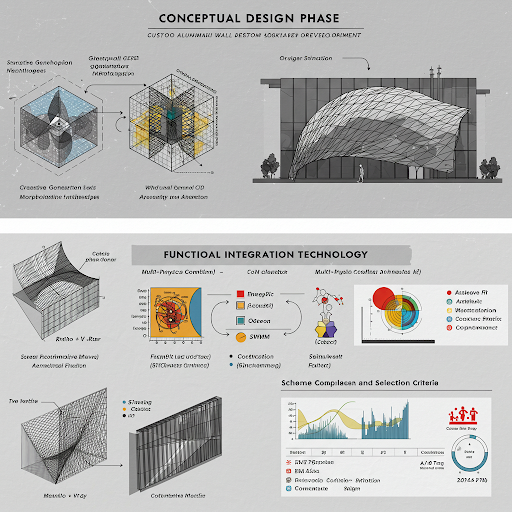
2.3 Confronto degli Schemi e Criteri di Selezione
| Indicatore | Peso | Metodo di Valutazione |
|---|---|---|
| Adattamento Estetico | 30% | Test A/B Multi-schemi |
| Soddisfazione Funzionale | 25% | Scheda di Valutazione Multi-dimensionale |
| Convenienza Economica | 20% | Analisi dei Costi del Ciclo di Vita |
| Fattibilità Costruttiva | 15% | Simulazione di Costruzione BIM |
| Comodità Operativa | 10% | Anteprima del sistema di gestione operativa e manutentiva FM |
(3) Progettazione Dettagliata e Soluzioni Tecniche
3.1 Progettazione della Sicurezza Strutturale
Analisi agli Elementi Finiti (ETABS):
- Condizioni di Combinazione del Carico del Vento (16 calcoli dell'angolo di direzione del vento).
- Analisi dello Spettro di Risposta Sismica (considerando le azioni sismiche SS/S1).
- Test di Fatica dei Nodi di Connessione (simulazione ANSYS).
3.2 Integrazione di Tecnologie ad Alta Efficienza Energetica
Sistema di Facciata Dinamica:
- Vetro Elettrocromico (trasmittanza luminosa regolabile 5%-70%).
- Parete Continua Fotovoltaica (tasso di conversione BIPV 22%+).
- Verdura Verticale (raffreddamento quotidiano di 3-5℃).
3.3 Sistema di Protezione della Sicurezza
- Progettazione della Cintura di Isolamento Antincendio (conformemente agli standard NFPA 285).
- Sistema di Prevenzione delle Cadute (conformemente agli standard EN 13374).
- Calcolo della Protezione contro i Fulmini (metodo della sfera rotante per il calcolo del raggio).

(4) Catena di Strumenti di Progettazione Digitale
4.1 Applicazione del Ciclo di Vita BIM
- Classificazione della Profondità del Modello (LOD100-LOD500).
- Piattaforma di Collaborazione Multidisciplinare (Revit + Navisworks).
- Simulazione di Costruzione 4D (integrata con il programma Primavera).
4.2 Applicazioni Software Specializzate
- Ottimizzazione Facciata: GenerativeComponents.
- Simulazione dell'illuminazione: DIALux evo.
- Analisi del flusso pedonale: Pathfinder.
4.3 Potenziamento con Tecnologia VR/AR
- Revisione dello schema di Realtà Mista: Overlay schema sul sito HoloLens.
- Sviluppo di programmi interattivi con Unity Engine.
- Esperienza immersiva (supporta la collaborazione multi-utente).
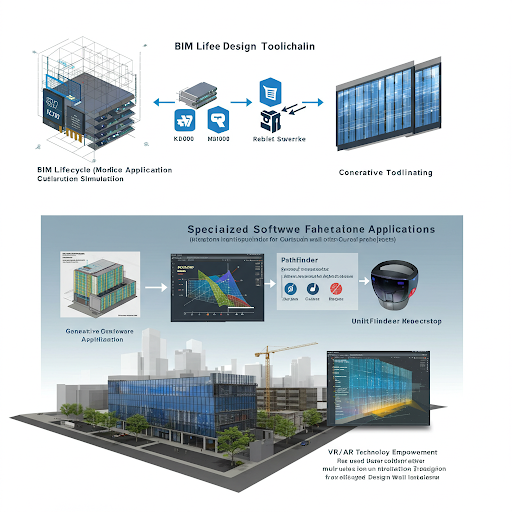
(5) Feedback del cliente e ottimizzazione dello schema
5.1 Modalità di progettazione partecipativa
- Revisione in stile workshop: Modello Digital Twin modifica in tempo reale.
- Confronto parallelo di più schemi.
- Esperienza in showroom virtuale.
5.2 Sistema di verifica della simulazione
- Test di prototipo fisico: Modello in scala 1:10 test nel tunnel del vento.
- Test di prestazioni di isolamento termico: Hot Box.
- Test di invecchiamento della durabilità del colore con lampada a xenon.
5.3 Standard di finalizzazione dello schema
- Revisione con scansione laser 3D.
- Conversione del disegno di lavorazione in CAM.
- Ottimizzazione della progettazione dell'organizzazione di costruzione.
II. Standard di configurazione del team di progettazione professionale
(1) Composizione del team principale
| Ruolo | Requisiti di background professionale | Fase di leadership |
|---|---|---|
| Progettista di facciate continue | Laurea doppia in Architettura + Ingegneria strutturale | Processo completo |
| Ingegnere BIM | Certificazione di Modellazione delle Informazioni Edilizie | Costruzione/Collaborazione del modello |
| Ingegnere di integrazione MEP | Competenza nel sistema HVAC | Prenotazione attrezzature/Coordinamento delle tubazioni |
| Consulente di sostenibilità | Certificazione LEED AP | Soluzioni a risparmio energetico/Applicazione per la certificazione |
| Ingegnere di lavorazione | Esperienza nel processo di formatura dei materiali | Dettaglio Nodo/Ottimizzazione del Processo |
(2) Innovazione nella Modalità di Collaborazione
- Piattaforma di Collaborazione Cloud (BIM 360 Design).
- Sistema di Archiviazione Blockchain (Registri di Modifiche dello Schema).
- Standard di Consegna Digitale (Formato COBie).
III. Tendenze di Sviluppo del Settore e Prospettive Tecnologiche
(1) Direzioni di Integrazione Tecnologica
- Progettazione Generata dall'Intelligenza Artificiale: generazione di facciate di edifici basata su StyleGAN.
- Gemello Digitale: monitoraggio virtuale dell'intero processo di costruzione.
- Costruzione Robotizzata: sistema di installazione intelligente per pannelli unitari.
(2) Percorsi di Miglioramento delle Prestazioni
- Pannelli Compositi in Calcestruzzo ad Alte Prestazioni (UHPC).
- Applicazione di Materiale Isolante Termico in Aerogel.
- Facciata con Sensore Radar a Onde Millimetriche.
(3) Prospettive di Applicazione sul Mercato
- Edifici a Energia quasi Zero che rappresentano l'80% entro il 2030.
- Dimensione del mercato di rinnovamento di facciate intelligenti superiore a 50 miliardi.
- Crescita dell'Applicazione della Tecnologia di Pareti Continua Stampate in 3D di 20 volte.
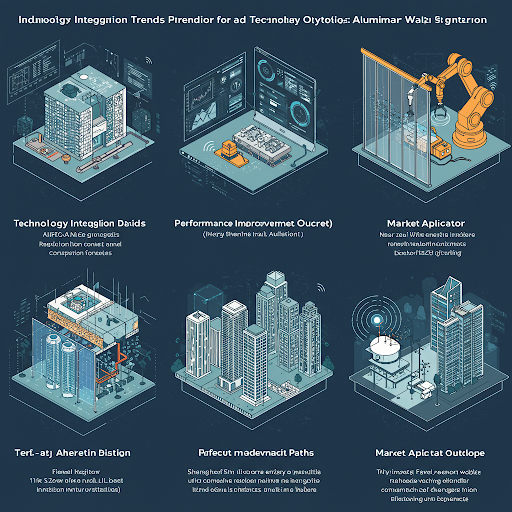
Progettazione Personalizzata di Pareti Continua in Alluminio: Analisi Completa di Materiali, Artigianato e Estetica
Nella progettazione architettonica moderna, le pareti continue in alluminio sono emerse come soluzione esterna preferita per edifici di grandi altezze e complessi commerciali grazie ai loro vantaggi unici. Come esperti di contenuti SEO, questo articolo approfondisce gli elementi fondamentali di progettazione di facciate continue in alluminio personalizzate, dalle proprietà dei materiali alle scelte artigianali, dalla performance ambientale alla presentazione estetica, mettendo in mostra la profondità professionale di questo settore. L'articolo ruoterà attorno alla parola chiave principale “progettazione di facciate continue in alluminio personalizzate,” garantendo che la sua frequenza si aggiri intorno a 5% per soddisfare le esigenze di ottimizzazione SEO mantenendo al contempo una leggibilità naturale.
I. Vantaggi rivoluzionari delle leghe di alluminio
Nel campo dei materiali da costruzione, le leghe di alluminio stanno ridefinendo gli standard di progettazione delle facciate continue con i loro vantaggi rivoluzionari. La loro resistenza alla corrosione deriva dal sottile strato protettivo di allumina naturale formato sulla superficie, che protegge efficacemente dagli elementi ambientali aggressivi come pioggia acida e spray salino. Rispetto all'acciaio tradizionale, la leggerezza dell'alluminio riduce il carico complessivo dell'edificio del 30-40%, offrendo maggiore libertà progettuale per strutture super alte. La riciclabilità dell'alluminio sottolinea ulteriormente il suo valore ambientale, con un tasso di riciclo fino al 95% per l'alluminio di scarto, realizzando davvero la circolarità delle risorse.

II. Proprietà dei materiali e sostenibilità
2.1 Analisi approfondita delle performance ambientali
La produzione di alluminio tramite elettrolisi consuma circa 13.500 kWh per tonnellata, ma la tecnologia di riciclo dell'alluminio riduce il consumo energetico al di sotto di 5.000 kWh. Le emissioni di carbonio durante il ciclo di vita sono inferiori di 40% rispetto a quelle dell'acciaio, in linea con gli standard di certificazione LEED per edifici verdi. I pannelli di alluminio trattati appositamente possono anche ottenere effetti fotocatalitici, decomponendo gli inquinanti NOx presenti nell'aria.
2.2 Adattabilità a ambienti estremi
In zone costiere con nebbia salina elevata, l'uso di lega di alluminio 6063-T5 abbinato a trattamenti di anodizzazione migliora la resistenza alla corrosione di 8 volte. Per regioni con differenze di temperatura superiori a 80°C, formulazioni speciali di leghe possono stabilizzare il coefficiente di dilatazione termica sotto 23,8×10⁻⁶/°C, garantendo la stabilità strutturale della facciata continua.
III. Matrice delle tecnologie di trattamento superficiale
| Tecnologia di trattamento | Resistenza alle intemperie (anni) | Lucentezza (%) | Ciclo di manutenzione | Scenari applicabili |
|---|---|---|---|---|
| Rivestimento in polvere | 10-15 | 30-60 | 8-10 anni | Edifici commerciali |
| Rivestimento in PVDF | 15-20 | 10-30 | 10-12 anni | Edifici di Rilievo |
| Trasferimento della Venatura del Legno | 8-12 | 5-15 | 6-8 anni | Edifici Culturali |
| Texture di Pietra Fluorocarbon | 20+ | 5-10 | 12-15 anni | Edifici Super Alti |
Punti Salienti Tecnici: Il processo a tre mani e doppia cottura garantisce un'adesione del rivestimento di livello 1, con particelle ceramiche a nano scala che migliorano la resistenza ai raggi UV. La tecnologia di formatura a freddo più recente consente superfici 3D testurizzate su pannelli sottili da 2 mm.
IV. Segreti Meccanici dei Sistemi di Connessione
4.1 Design del Telaio Nascosto vs. Esposizione
- Sistema a Telaio Nascosto: Utilizza adesivo strutturale in silicone per il bonding, raggiungendo un errore di planarità complessivo inferiore a 0,5 mm e una resistenza al carico del vento di 6,0 kPa. Tuttavia, i costi di riparazione sono più elevati, rendendolo adatto per edifici di rilievo in città di primo livello.
- Sistema a Telaio Esposto: Realizza giunti visibili tramite cappucci di copertura, aumentando l'efficienza di installazione del 40%, ma gli effetti di ponte termico richiedono ottimizzazione tramite profili in alluminio断桥.
4.2 Confronto delle Tecnologie di Fissaggio
| Tipo di Tecnologia | Resistenza Sismica | Conducibilità Termica | Efficienza di Installazione |
|---|---|---|---|
| Silicone Strutturale | Alto | 1,8W/(m·K) | Basso |
| Connessione a Vite | Medio | 0,5W/(m·K) | Alto |
| Tecnologia di Saldatura | Basso | 80W/(m·K) | Medio |
Applicazioni Innovative: Adesivi strutturali in silicone a due componenti combinati con monitoraggio a laser della posizione garantiscono errori di larghezza della linea di colla inferiori a 0,3 mm. Viti autofilettanti e avvitatrici auto-trancianti consentono l'installazione su un lato solo, aumentando l'efficienza del 60%.
V. Evoluzione dei Processi di Produzione di Precisione
5.1 Matrice di Attrezzature CNC
- Centri di lavorazione a cinque assi: Raggiungi una precisione di lavorazione di 0,02 mm, in grado di tagliare superfici curve 3D.
- Presse a punzonatura CNC: 1200 colpi al minuto con precisione di posizione del foro di ±0,1 mm.
- Macchine per incisione laser: Permettono la lavorazione di micro-fori da 0,1 mm per esigenze di illuminazione speciali.

5.2 Sistema di Controllo Qualità
- Ispezione Inline: Gli imagers termici a infrarossi monitorano la planarità del pannello con precisione di 0,05 mm/m².
- Test Distruttivi: 3% di ogni lotto sottoposto a test di nebbia salina (3000h) e test di trazione (>160MPa).
- Tracciabilità Digitale: I codici QR registrano 30 punti dati dai lotti di materie prime ai parametri di lavorazione.
Progettazione Personalizzata di Facciate in Alluminio: Soluzioni Innovative per l'Efficienza Energetica e l'Ambiente degli Edifici Sostenibili
I. Filosofia di Progettazione a Risparmio Energetico: Concetto Chiave degli Edifici Verdi
Nel campo degli edifici sostenibili, la filosofia di progettazione a risparmio energetico è il “filo d’oro” che attraversa tutto il ciclo di progettazione. La sua essenza risiede nel raggiungimento dei tre obiettivi di conservazione delle risorse, rispetto per l’ambiente e ottimizzazione dei costi attraverso una pianificazione scientifica.
- Riciclo delle Risorse: Riduzione del consumo di risorse utilizzando materiali riciclabili (come facciate in alluminio personalizzate) e prolungando la durata dell’edificio attraverso un design modulare.
- Simbiosi Ambientale: Utilizzo di fonti di energia rinnovabile come solare ed eolico, combinato con un design passivo (ad esempio, illuminazione naturale, ventilazione) per ridurre il consumo energetico.
- Ottimizzazione dei Costi: Riduzione delle spese operative attraverso tecnologie a risparmio energetico, come le caratteristiche di basso costo di manutenzione di facciate in alluminio personalizzate riducendo significativamente le spese a lungo termine.
II. Tecnologie di Isolamento Termico, Isolamento Acustico e Controllo delle Radiazioni Solari: Creare Spazi Confortevoli
(1) Aggiornamento della Tecnologia di Isolamento Termico
- Applicazione di Nano-ricopertura: Aggiunta di rivestimenti isolanti termici a scala nanometrica su superfici di facciate continue in alluminio, con riflettività superiore a 85%, riducendo efficacemente la temperatura delle superfici dell'edificio.
- Materiale Poroso Composito: Pannelli in alluminio personalizzati riempiti con aerogel o pannelli isolanti sottovuoto, raggiungendo una conduttività termica fino a 0,01W/(m·K), realizzando una “super isolamento”.
(2) Innovazione nella Tecnologia di Isolamento Acustico
- Struttura Cavea a Doppio Strato: Facciate continue in alluminio personalizzate con design a doppio strato di vetro cavo + anima in nido d'ape in alluminio, con isolamento acustico fino a 45dB o più, soddisfacendo le esigenze di ambienti ad alto rumore come aeroporti e stazioni di alta velocità.
- Algoritmo di Ottimizzazione Acustica: Regolazione della porosità e degli angoli della facciata continua tramite simulazione computerizzata per ottenere un'assorbimento direzionale di rumore a frequenza specifica.
(3) Controllo delle Radiazioni Solari
- Sistema di Ombreggiatura Dinamica: Integrazione di lamelle fotovoltaiche o vetro elettrocromico, regolando automaticamente la trasmittanza luminosa in base all'intensità della luce solare per garantire l'illuminazione evitando l'abbagliamento.
- Strato di Schermatura alle Radiazioni: Aggiunta di rete metallica o film di grafene nello strato intermedio del pannello in alluminio per bloccare efficacemente le radiazioni ultraviolette (UVR) e infrarosse (IRR).

III. Applicazione Approfondita delle Facciate Continue in Alluminio negli Edifici Ecologici
(1) Vantaggi della Progettazione Personalizzata
- Flessibilità di Modellazione: Realizzazione di forme complesse come curve e scanalature tramite lavorazioni CNC e taglio laser per soddisfare le esigenze personalizzate di edifici di rilievo.
- Integrazione Funzionale: Incorporazione di illuminazione LED, componenti fotovoltaici, sistemi di raccolta dell'acqua piovana nella struttura della facciata continua in alluminio per ottenere “facciate multifunzionali”.
(2) Benefici ambientali dell'intero ciclo di vita
- Fase di produzione: Utilizzo di alluminio riciclato riducendo le emissioni di carbonio di 60% rispetto alle tradizionali pareti di rivestimento in pietra.
- Fase di utilizzo: Rivestimenti fluorocarbon resistenti alle intemperie che garantiscono ness fading del colore per 20 anni, riducendo la frequenza e i costi di manutenzione.
- Fase di riciclo: L'alluminio essendo riciclabile al 100%, formando un modello di “economia circolare”.
IV. Certificazione ambientale e standard: Approvazione internazionale autorevole
(1) Requisiti principali della certificazione LEED
- Trasparenza dei materiali: Richiesta di fornitura di un rapporto di Valutazione del ciclo di vita (LCA) per le pareti di rivestimento in alluminio dalla estrazione delle materie prime alla lavorazione.
- Contributo energetico: Dimostrazione tramite software di simulazione che il design della parete di rivestimento può ridurre il consumo energetico complessivo dell'edificio di più di 15%.
- Ambiente interno: Garantire l'assenza di emissioni di composti organici volatili (VOC) e rispettare rigorosi standard di qualità dell'aria interna.
(2) Metriche speciali della certificazione BREEAM
- Calcolo delle emissioni di carbonio: Richiesta che l'impronta di carbonio (CFP) delle pareti di rivestimento in alluminio sia inferiore di 20% rispetto alla media del settore.
- Adattabilità ecologica: Punti aggiuntivi per l'uso di alluminio prodotto localmente nel progetto per garantire una gestione forestale sostenibile.
(3) Sinergia FSC e Green Seal
- Abbinamento del legno: Se si combinano pareti a vetro in alluminio con componenti in legno, deve essere scelto legno certificato FSC per garantire una gestione forestale sostenibile.
- Produzione Pulita: Certificazione Green Seal che richiede un tasso di riutilizzo delle acque reflue pari all'85% durante la produzione.

V. Sostenibilità dei Materiali e Design Circolare: Orientato al Futuro
(1) Integrazione di Materiali Biobased
- Pannelli Compositi a Mycelium: Utilizzo della tecnologia di stampaggio a crescita di micelio sul retro delle pareti a vetro in alluminio per ottenere adesione naturale e degradabilità.
- Riempitivo di Alghe: Utilizzo di estratti di alghe come ritardanti di fiamma nei nuclei dei pannelli in alluminio, sostituendo i ritardanti di fiamma chimici tradizionali.
(2) Design Circolare Modulare
- Connettori Rimovibili: Utilizzo di connettori a scatto o magnetici per la sostituzione rapida delle unità di pareti a vetro in alluminio.
- Identificazione della Selezione dei Materiali: Stampa di codici QR sul retro dei pannelli in alluminio per registrare la composizione dei materiali e i percorsi di riciclo.
VI. Tecnologie Intelligenti e Integrate: La “Rivoluzione Smart” delle Pareti
(1) Architettura del Sistema di Pareti Intelligenti
- Rete di Sensori: Integrazione di sensori di temperatura, umidità, PM2.5 e velocità del vento per monitorare i parametri ambientali in tempo reale.
- Algoritmo di Decisione AI: Prevedere i cambiamenti meteorologici tramite apprendimento automatico per regolare automaticamente gli angoli di apertura della parete a vetri.
(2) Tecnologia Integrata di Pannelli Solari
- Moduli Fotovoltaici a doppio vetro: Incapsulamento di celle sottili di tellururo di cadmio (CdTe) in vetro a doppio strato, raggiungendo un'efficienza di generazione di energia di 16%.
- Tecnologia di Protezione Hot Spot: Utilizzo di diodi di bypass per prevenire l'attenuazione della potenza a causa di ombreggiature parziali.
(3) Innovazione nel Sistema di Ombreggiatura Dinamica
Supporto di Tracciamento Fotovoltaico: Azionamento degli angoli delle lamelle tramite motori per sempre rivolgere la faccia verso il sole, migliorando l'efficienza di generazione di energia.
Lamelle con Materiale a Cambiamento di Fase (PCM): Utilizzo di paraffina e altri materiali per assorbire calore durante il cambiamento di fase a 28°C, riducendo il carico di condizionamento dell'aria.

